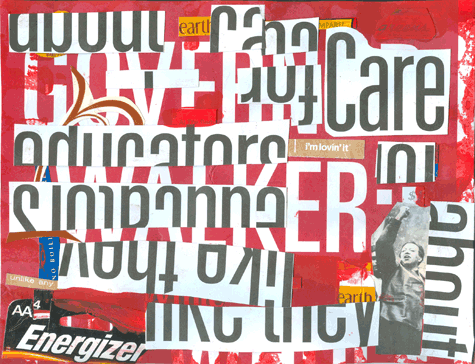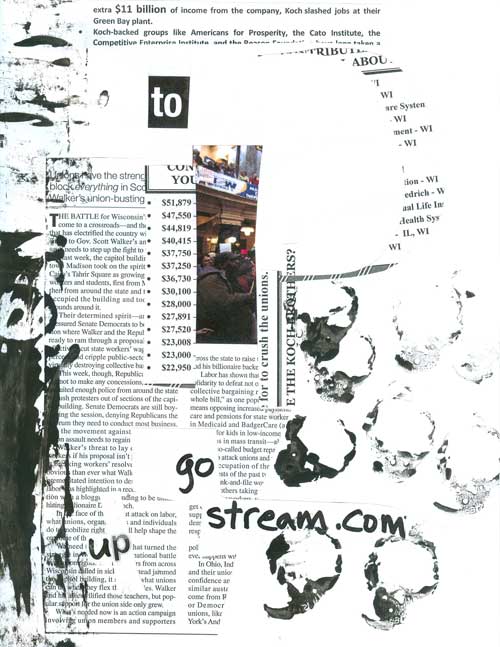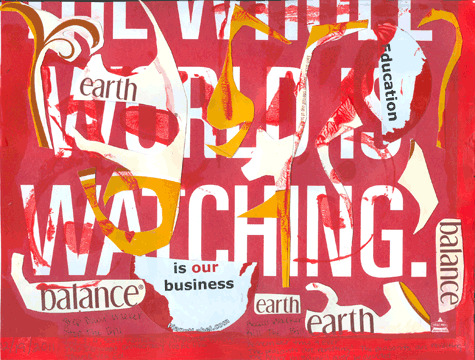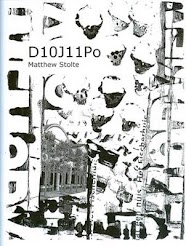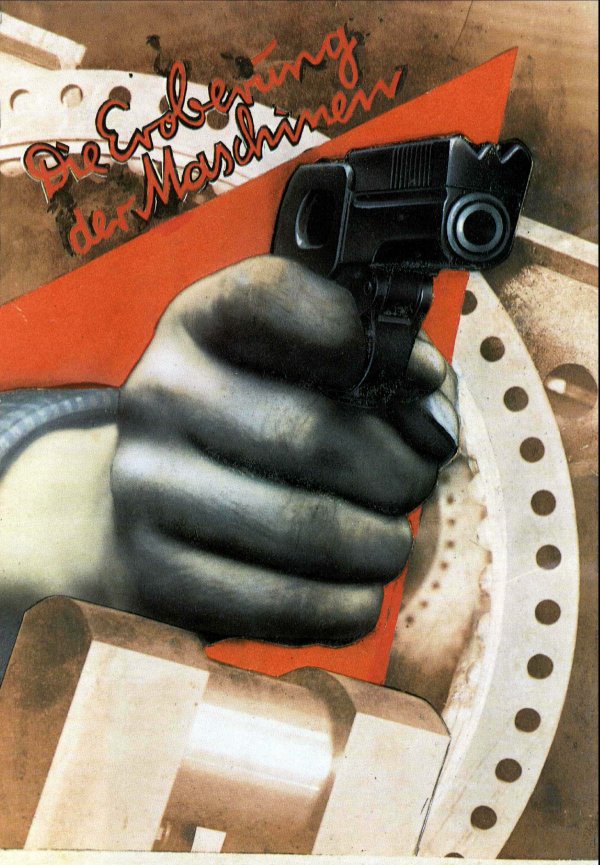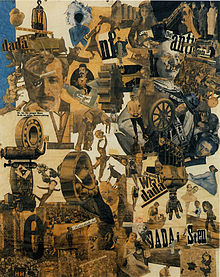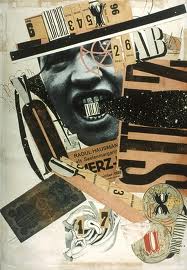Book Review
The Visual Poetry of Matthew Stolte: D10J11Po and WiProTestPo, eMTevispubs #5 and #6, 2011.
Reviewed by Lisa Vihos
Matthew Stolte, Gov Walker, 2011
Since 2010, artist-poet Matthew Stolte has been reproducing his visual poetry in a series of publications under his own imprint, eMTevispubs. There are six books to date with three new collections in the pipeline, according to Stolte. I first became aware of his work last year on the Verse Wisconsin Main Street online issue. Seeing his work one February morning on my laptop, I remember being jolted awake—in a way that my cup of coffee was not capable of waking me—by his jagged, disparate forms and bold colors. His piece called Heart seemed to express what the poets were saying about the breaking situation in Madison, but in a language that went beyond language.
Matthew Stolte, Heart, 2011
The images that appeared on the VW website are now in Stolte’s book, WiProTestPo. Almost all of the work Matthew created at that time (early 2011) came from discarded protest signs he found on the ground near the capitol, often in the snow; paper he had to dry out on the floor of his studio before he could cut it and turn it into visual poetry. The artist says he is still fond of using texts that he finds while riding his bike through the streets of Madison, and he gets a thrill locating “trash” that contains snippets of text that can then be transformed into new visual poems.
In D10J11Po (which refers to the dates that the images were created, between December 2010 and January 2011) Stolte employs complex compositional elements to invoke chaos, obfuscation, layers of meaning, blank spaces, broken promises, and our seeming inability to ever really get the full story. There is no narrative here, but his image-poems contain such focal points as a smiling mother and baby, a strange dog, the word “OR,” ominous black-robed figures aiming handguns on what appears to be a beach, a photograph of a shark, a line drawing of a cow, the word MEMORY, a pair of bare feet, a woman’s seductive smile, a sunburst arrangement of the letters e, s, b, s.
This disparate conglomerate of signs and symbols serves to remind the viewer that we must always stay alert, read between the lines, and do our best every day to put information together from a myriad of sources. In the Internet age, nothing about what we know or are told comes to us in a neat and tidy package anymore. Stolte’s poems make us practice how to sift through the quagmire to understand what is happening to us and what is happening around us.
He continues this same aesthetic in the book already mentioned at the beginning of this review, WiProTestPo, where works such as Gov Walker, World Watching, Heart, and Go Stream are joined together with about a dozen other images to tell the narrative of the Great Walker Debacle. The story begins with correspondence that Matthew received from representatives Mark Pocan and Fred Risser at the end of 2010, thanking him for his thoughts on the high-speed rail that was ultimately squashed by Walker. With each turn of the page, we find yet another compelling image that captures the mounting awareness that our new governor most certainly did not have the best interests of Wisconsin at heart. Toward the end of the book, we see an image from “Tractor Day,” a worker holding a sign in Spanish, a little girl with a sign that says “We [Heart] Teachers!”
Matthew Stolte, Go Stream, 2011
Again, many of these works are similar to the work in D10J11Po, as Stolte continues to explore truncated words and overlapping forms in collage-like cacophonies that yell at us—loud and raw—and that perfectly capture the feeling of chaos and confusion that many of us felt beginning in February, 2011. “How can this be happening?” we wondered. Matthew’s images reflect our surprise and distress, our need to act, our need to protest. There are the artist’s own typed “journal notes” and hand-written messages (notes-to-self one might find by the telephone or on the refrigerator, for example), as though we are privy to the day-by-day musings of the artist as he was trying to both make sense of and comment on what was taking place before his very eyes. A journal entry marked 2/12/11 at 7:36 a.m. reads:
didn’t paint last night – which is usual for Friday night. stood around drinking wine listening to Jella Biafra CDs – which has also been usual. The news infuriated me last night, what with our new Gov. [blanked out] f[blanked out]ing with the Unions. Funny I nearly ran into him on my way out the door as he & his entourage were heading out of the neighboring building, WI Manufacturers. He gave a speech a few hours later at the capitol.
As stated at the end of the book, all the works in WiProTestPo also appeared in an exhibition documenting the Wisconsin protests called SolidARTity (March 1-9, 2011) at Project Lodge, a cooperative multi-media arts collective in Madison. Much of what appeared in SolidARTity included signs and messages that were created by anonymous people, not so much as “art,” but as public outcry taped up in the marble halls of the capitol. If you got the chance to stand in the soaring rotunda last February and hear the fire fighters’ bagpipes, and feel the pulse of the teens from a Milwaukee drumline and stand with thousands of other people singing “We Shall Overcome,” you know what I am talking about. The whole interior of the rotunda and all the hallways spoking off from the center were plastered with words, messages, post-it notes, emails, and pleas for justice. Much of this spontaneous expression, including Matthew’s artwork, is now in the collection of the Wisconsin State Historical Society where it will stand as a physical manifestation of the united voice that spoke up against Walker’s draconian policies.
Matthew Stolte, World Watching, 2011
In June of 2011, I got to meet Matthew at a reading that we both participated in at Olbrich Gardens. At that event, he shared poems he had written about the BP oil spill. These works were highly visual but they also had a textual component that could be both read and spoken. I was so impressed by Matthew’s focused vision and his ability to comment on highly-charged issues in a manner that is unique, breath-taking, and visceral.
When I first made my way through his printed work, I was immediately reminded of the work of the German Dada artists of the early 20th century, such as Raoul Hausmann, Hannah Hoch, and John Heartfield. I asked Matthew if these artists were at all on his mind, and although he is familiar with them, he does not view them as direct inspiration as much as some of the more recent makers of visual poetry like the artists associated with the Fluxus movement of the 1960s and even more recently, Xexoxial Editions, and Xerox Sutra Editions, examples of which are abundant on the Internet.
Although the German Dadaists might not have referred to their work as “visual poetry” either, to my eye, the impetus and the aesthetic to be found in Matthew’s work is very similar: to use words and images to shake up reality; to wake up the viewer to injustices or cultural shifts that need to be rigorously questioned. For the German artists so long ago, it was the arrogance of the bourgeoisie and later the rise of fascism that needed to be stopped. For us? Look at Matthew’s work. Let it wash over you, engulf you. Perhaps not everything will make sense on first view, but the longer you look, the more you will see. Then, you decide what to do.
The poems of Lisa Vihos have appeared in numerous small journals. She has one chapbook, A Brief History of Mail(Pebblebrook Press), with a second, The Accidental Present, soon to appear from Finishing Line Press. She was recently nominated for a Pushcart Prize. She is an associate editor of Stoneboat literary journal and an occasional guest blogger for The Best American Poetry. She lives in Sheboygan.

